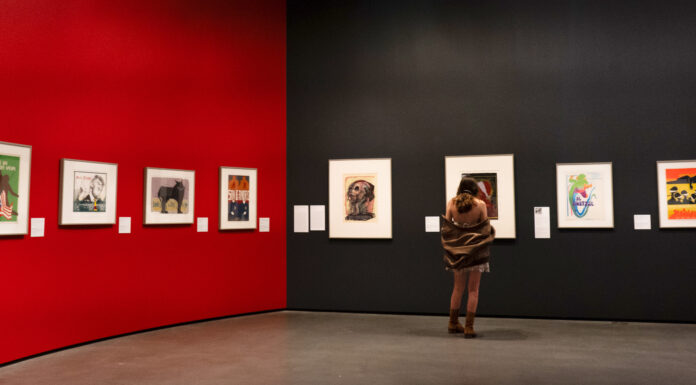“Malaquias Montoya and the Legacies of a Printed Resistance”
By EMME DUNNING — features@theaggie.org
The Manetti Shrem Museum of Art is a free museum located on the UC Davis campus and a pillar of the art community in town. Its exhibitions have ranged in content from Roy De Forest’s whimsical “Habitats for Travelers” to the striking work of Mike Henderson’s “Before the Fire.” Despite their differences in theme and topic, they all share a common goal — to help UC Davis students and the greater community connect, whether to the planet, to social issues or to each other.
One such exhibit, “Malaquias Montoya and the Legacies of a Printed Resistance,” has made a considerable impact on the Davis community. The display, which opened in early October 2023 and just recently came to a close in early May of this year, consisted of a collection of protest prints with topics ranging from union and labor rights to immigration and criminal justice reform. Walking through the exhibit, visitors were encouraged to spend time with each print and understand the varying causes they represented.
Among the collection were prints made by artist and UC Davis Emeritus Professor Malaquias Montoya, who played a prominent role in the creation of the exhibit itself. Montoya has an extensive background in the art community, specifically in regards to protest art. The UC Berkeley graduate has centered his work around social justice issues for decades, integrating these principles into his personal works and as his curriculum during his time as a teacher at Stanford, UC Berkeley, UC Davis and the California College of Arts and Crafts in Oakland.
For Montoya, these prints hold a deeper meaning beyond aesthetics. In his biography, the artist noted his personal connection to the art he creates and how it serves as a form of activism and expression.
“As a Chicano artist I feel a responsibility that all my art should be a reflection of my political beliefs — an art of protest,” Montoya said. “The struggle of all people cannot be merely intellectually accepted. It must become part of our very being as artists otherwise we cannot give expression to it in our work.”
Montoya remains highly involved in art and protest in his community and is closely involved with an art space in Woodland, Taller Arte del Nuevo Amanece (TANA). The space is part of the Chicana/o studies department at UC Davis and provides both UC Davis students and Woodland community members with the resources and expertise to continue the tradition of printmaking, as well as a gallery and exhibition area to display work.
Walter Jackson, a third-year design student at UC Davis, worked with Montoya in the summer of 2023 through an internship with the Manetti Shrem. Through this internship, Jackson was able to learn the process of printmaking first-hand at TANA and gain insight into Montoya’s rich history of printmaking.
“[Montoya] wants people to understand the deeper meaning behind what he’s printing and the art piece,” Jackson said. “He wants us to understand these issues. Though they look pretty on paper, they’re something that needs to be dealt with in the real world and we should be talking about it. He uses [art] as an expression, and I feel like that’s what we all should do. You really don’t know what kind of forms of art or projects will be implemented in the history books. He’s created something that’s a form of expression, but it’s also history.”
Historically, protest art has been integral to the success of social justice movements. The process of screen printing is unique from other forms of art in its ability to be quickly reproduced, making it ideal for use at rallies and protests where getting the word out widely and quickly is integral.
This goal of mass production and distribution also helps to inform how the prints themselves are designed by artists before printing. For the current Manager of Visitor Experience at the Manetti Shrem Cesar Chavez, this rapid distribution is a cornerstone of the unique style.
“[The prints] were meant to be seen from 40 feet away, so it was kind of a quick thing that they could create very quickly and get out there and use, and now it is seen as art,” Chavez said. “That’s always stuck with me. When you’re trying to get the word out and you’re trying to express how you feel about a certain topic, it can be a very powerful tool to use.”
Because the prints must be identifiable and eye-catching from far distances, sharp colors and imagery are trademark features of this art medium. In contrast to the experience of seeing these prints out on the streets in a fast-moving environment, observing them in a museum setting allows patrons to take in all the details of the work and take time to understand the messages behind them.
Sydney Makar, a third-year aerospace engineering major who recently visited the “Malaquias Montoya and the Legacies of a Printed Resistance” exhibit, took note of this unique style.
“I saw a lot of words and colors jumping out at you,” Makar said. “The fact that so many people sat down and made entire paintings about [the causes] and put so much effort and detail really shows the emotions people feel. [This art] can allow people like myself to understand in some way how people feel about these topics.”
These prints are not just historical, either. On our own UC Davis campus, screen printing was used at a recent May Day rally for Palestine to print on dozens of shirts and posters for supporters of the cause, continuing the longstanding relationship between art and activism. Although Montoya’s exhibit has come to an end, protest prints remain an important part of social justice movements globally.
Written by: Emme Dunning — features@theaggie.org





